
Cathédrale Saint-Sauveur d'Aix
Encyclopedia

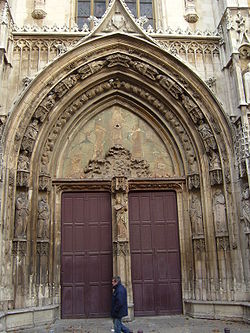
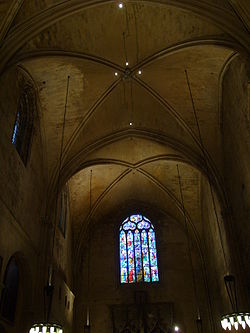
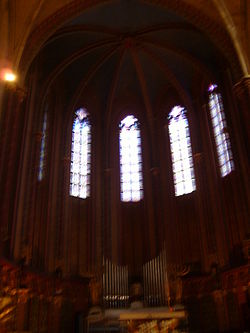
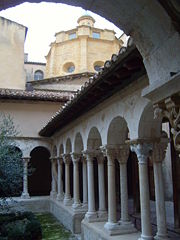
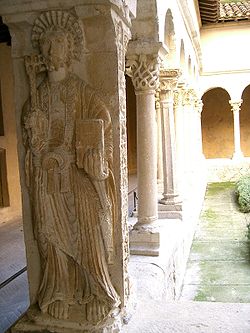
Aix-en-Provence
Aix , or Aix-en-Provence to distinguish it from other cities built over hot springs, is a city-commune in southern France, some north of Marseille. It is in the region of Provence-Alpes-Côte d'Azur, in the département of Bouches-du-Rhône, of which it is a subprefecture. The population of Aix is...
in southern France
France
The French Republic , The French Republic , The French Republic , (commonly known as France , is a unitary semi-presidential republic in Western Europe with several overseas territories and islands located on other continents and in the Indian, Pacific, and Atlantic oceans. Metropolitan France...
is a Roman Catholic cathedral and the seat of the Archbishop of Aix. It is built on the site of the 1st century Roman forum
Forum (Roman)
A forum was a public square in a Roman municipium, or any civitas, reserved primarily for the vending of goods; i.e., a marketplace, along with the buildings used for shops and the stoas used for open stalls...
of Aix. Built and re-built from the 12th until the 19th century, it includes Romanesque
Romanesque architecture
Romanesque architecture is an architectural style of Medieval Europe characterised by semi-circular arches. There is no consensus for the beginning date of the Romanesque architecture, with proposals ranging from the 6th to the 10th century. It developed in the 12th century into the Gothic style,...
, Gothic
Gothic architecture
Gothic architecture is a style of architecture that flourished during the high and late medieval period. It evolved from Romanesque architecture and was succeeded by Renaissance architecture....
and Neo-Gothic elements, as well as Roman columns and parts of the baptistery
Baptistery
In Christian architecture the baptistry or baptistery is the separate centrally-planned structure surrounding the baptismal font. The baptistry may be incorporated within the body of a church or cathedral and be provided with an altar as a chapel...
from a 6th century Christian church. It is a national monument of France.
Legends about its origin
The cathedral is located on the route of an ancient Roman roadRoman road
The Roman roads were a vital part of the development of the Roman state, from about 500 BC through the expansion during the Roman Republic and the Roman Empire. Roman roads enabled the Romans to move armies and trade goods and to communicate. The Roman road system spanned more than 400,000 km...
, the Via Aurelia
Via Aurelia
The Via Aurelia was a Roman road in Italy constructed around the year 241 BC. The project was undertaken by C. Aurelius Cotta, who at that time was censor...
. A fragment of a Roman wall and the columns of the baptistery seem to be the origin of the legend that the church was built on top of a Roman temple dedicated to Apollo
Apollo
Apollo is one of the most important and complex of the Olympian deities in Greek and Roman mythology...
. The historian Pitton (1668) claimed that the temple had been dedicated to a sun god, basing his claim upon the discovery of the leg of a statue uncovered at the site.
According to the Christian tradition, the first church on the site was founded by Saint Maximinus of Aix, who arrived in Provence from Palestine
Palestine
Palestine is a conventional name, among others, used to describe the geographic region between the Mediterranean Sea and the Jordan River, and various adjoining lands....
with Mary Magdalene
Mary Magdalene
Mary Magdalene was one of Jesus' most celebrated disciples, and the most important woman disciple in the movement of Jesus. Jesus cleansed her of "seven demons", conventionally interpreted as referring to complex illnesses...
on a boat belonging to Lazarus
Lazarus of Bethany
Lazarus of Bethany, also known as Saint Lazarus or Lazarus of the Four Days, is the subject of a prominent miracle attributed to Jesus in the Gospel of John, in which Jesus restores him to life four days after his death...
. Maximin built a modest chapel on the site of the present cathedral and dedicated it to the Holy Saviour (le Saint Sauveur).
Destruction of the ancient chapel
During the invasion of the Saracens in the 8th and 9th centuries, the original chapel of Saint-Sauveur was destroyed.Construction of the Cathedral
Around the year 500, under the Bishop Basilius, a group of episcopal buildings was constructed on top of the old Roman forum, including a chapel, a baptistery and several other rooms.At the beginning of the 12th century, a new church was begun on the same site, with Romanesque walls bearing the three bays of a wide single nave, constituting a parish church dedicated to the Virgin Mary (Notre Dame de la Sède).
A second nave, dedicated to Saint Maximinus, was built in about 1165-1177 as the church of the canons
Canon (priest)
A canon is a priest or minister who is a member of certain bodies of the Christian clergy subject to an ecclesiastical rule ....
, which was located between the first nave and the baptistery. The choir of this church ended in a flat chevet wall, which connected by a door with the Sainte-Chapelle, part of the original 6th century episcopal buildings. The chapel was rebuilt in the 12th century, and when the Gothic nave was added, was incorporated into the cathedral and became the oratory of the Saviour. It was destroyed in 1808.
At the end of the 12th century and beginning of the 13th century, Aix became the capital of Provence, and the city's population and importance grew rapidly. Religious orders began to arrive; the Franciscans first, then the Dominicans
Dominican Order
The Order of Preachers , after the 15th century more commonly known as the Dominican Order or Dominicans, is a Catholic religious order founded by Saint Dominic and approved by Pope Honorius III on 22 December 1216 in France...
, Carmelites
Carmelites
The Order of the Brothers of Our Lady of Mount Carmel or Carmelites is a Catholic religious order perhaps founded in the 12th century on Mount Carmel, hence its name. However, historical records about its origin remain uncertain...
, and Augustinians
Augustinians
The term Augustinians, named after Saint Augustine of Hippo , applies to two separate and unrelated types of Catholic religious orders:...
, building new churches, monasteries and convents.
A surge of construction on the cathedral paralleled the growth of importance of Aix. Two new wings of the transept
Transept
For the periodical go to The Transept.A transept is a transverse section, of any building, which lies across the main body of the building. In Christian churches, a transept is an area set crosswise to the nave in a cruciform building in Romanesque and Gothic Christian church architecture...
, built in the Gothic style, were begun in about 1285-1290, and finished in 1316. Bay by bay, the old Romanesque church was transformed into a Gothic cathedral.
The building of the new church was interrupted by the Black Death
Black Death
The Black Death was one of the most devastating pandemics in human history, peaking in Europe between 1348 and 1350. Of several competing theories, the dominant explanation for the Black Death is the plague theory, which attributes the outbreak to the bacterium Yersinia pestis. Thought to have...
and then the Hundred Years' War
Hundred Years' War
The Hundred Years' War was a series of separate wars waged from 1337 to 1453 by the House of Valois and the House of Plantagenet, also known as the House of Anjou, for the French throne, which had become vacant upon the extinction of the senior Capetian line of French kings...
. Work did not resume for 130 years, until 1472, when the last bay was built. The façade took another thirty years, and the last statues were not put in place until 1513, at the beginning of the Renaissance
Renaissance
The Renaissance was a cultural movement that spanned roughly the 14th to the 17th century, beginning in Italy in the Late Middle Ages and later spreading to the rest of Europe. The term is also used more loosely to refer to the historical era, but since the changes of the Renaissance were not...
.
The Façade and Bell Tower
The original Romanesque front of Saint Mary's nave was destroyed in the 15th century, and replaced with a new Gothic front and a bell tower.The façade features four statues by Jean Mone, made in 1512-1513, on the middle level: Saint Mitre
Saint Mitre
Mitre was a Catholic saint, who was born in Thessaloniki, Greece and died in Aix-en-Provence.-Biography:According to the legend, Mitre, a field worker living in Aix-en-Provence with Arvendus, was charged with witchcraft for making a miracle come true. He was beheaded...
(carrying his head); Saint Mary Magdalene
Mary Magdalene
Mary Magdalene was one of Jesus' most celebrated disciples, and the most important woman disciple in the movement of Jesus. Jesus cleansed her of "seven demons", conventionally interpreted as referring to complex illnesses...
, (carrying a flask of perfume); the boy-bishop Saint Louis of Toulouse
Louis of Toulouse
Saint Louis of Toulouse was a cadet of the royal French house of Anjou who was made a Catholic bishop. The California mission, city and county of San Luis Obispo, California, are named after him....
(d. 1297), the brother of Robert of Naples
Robert of Naples
Robert of Anjou , known as Robert the Wise was King of Naples, titular King of Jerusalem and Count of Provence and Forcalquier from 1309 to 1343, the central figure of Italian politics of his time. He was the third but eldest surviving son of King Charles II of Naples the Lame and Maria of Hungary...
, Count of Provence 1309-43; and the other Saint Louis
Louis IX of France
Louis IX , commonly Saint Louis, was King of France from 1226 until his death. He was also styled Louis II, Count of Artois from 1226 to 1237. Born at Poissy, near Paris, he was an eighth-generation descendant of Hugh Capet, and thus a member of the House of Capet, and the son of Louis VIII and...
, King Louis IX of France (d. 1270), his great-uncle.
Jacotin Paproche, from Picardy
Picardy
This article is about the historical French province. For other uses, see Picardy .Picardy is a historical province of France, in the north of France...
, sculpted the ten small prophet
Prophet
In religion, a prophet, from the Greek word προφήτης profitis meaning "foreteller", is an individual who is claimed to have been contacted by the supernatural or the divine, and serves as an intermediary with humanity, delivering this newfound knowledge from the supernatural entity to other people...
s and twenty cherubim (1484) on the façade. Pierre Souquet created the two statues on the upper level, representing the first two bishops of Aix, traditionally named as Maximinus and Sidonius.
The centrepiece of the façade is Saint Michael Crushing the Dragon (1507), by Jean Paumier, from Burgundy.
The façade originally also included twelve statues of the apostles and six statues on the tympanum
Tympanum (architecture)
In architecture, a tympanum is the semi-circular or triangular decorative wall surface over an entrance, bounded by a lintel and arch. It often contains sculpture or other imagery or ornaments. Most architectural styles include this element....
, which were destroyed during the French Revolution
French Revolution
The French Revolution , sometimes distinguished as the 'Great French Revolution' , was a period of radical social and political upheaval in France and Europe. The absolute monarchy that had ruled France for centuries collapsed in three years...
.
Carved doors
The doors of the cathedral were commissioned by the chapterCathedral chapter
In accordance with canon law, a cathedral chapter is a college of clerics formed to advise a bishop and, in the case of a vacancy of the episcopal see in some countries, to govern the diocese in his stead. These councils are made up of canons and dignitaries; in the Roman Catholic church their...
in 1505, and were carved of walnut by the brothers Raymond and Jean Bolhit of Aix and by the Toulon
Toulon
Toulon is a town in southern France and a large military harbor on the Mediterranean coast, with a major French naval base. Located in the Provence-Alpes-Côte-d'Azur region, Toulon is the capital of the Var department in the former province of Provence....
sculptor Jean Guiramand.
The doors feature four figures in high relief of the major prophets of the Old Testament
Old Testament
The Old Testament, of which Christians hold different views, is a Christian term for the religious writings of ancient Israel held sacred and inspired by Christians which overlaps with the 24-book canon of the Masoretic Text of Judaism...
(Isaiah
Isaiah
Isaiah ; Greek: ', Ēsaïās ; "Yahu is salvation") was a prophet in the 8th-century BC Kingdom of Judah.Jews and Christians consider the Book of Isaiah a part of their Biblical canon; he is the first listed of the neviim akharonim, the later prophets. Many of the New Testament teachings of Jesus...
, Ezekiel
Ezekiel
Ezekiel , "God will strengthen" , is the central protagonist of the Book of Ezekiel in the Hebrew Bible. In Judaism, Christianity and Islam, Ezekiel is acknowledged as a Hebrew prophet...
, Daniel
Daniel
Daniel is the protagonist in the Book of Daniel of the Hebrew Bible. In the narrative, when Daniel was a young man, he was taken into Babylonian captivity where he was educated in Chaldean thought. However, he never converted to Neo-Babylonian ways...
and Jeremiah
Jeremiah
Jeremiah Hebrew:יִרְמְיָה , Modern Hebrew:Yirməyāhū, IPA: jirməˈjaːhu, Tiberian:Yirmĭyahu, Greek:Ἰερεμίας), meaning "Yahweh exalts", or called the "Weeping prophet" was one of the main prophets of the Hebrew Bible...
).
Above the prophets are the figures of twelve Sybils
Sibyl
The word Sibyl comes from the Greek word σίβυλλα sibylla, meaning prophetess. The earliest oracular seeresses known as the sibyls of antiquity, "who admittedly are known only through legend" prophesied at certain holy sites, under the divine influence of a deity, originally— at Delphi and...
, pagan fortune-tellers from antiquity, honoured by medieval Christian scholars for having forecast the birth, death and resurrection of Christ.
The figures are framed with garlands of pomegranates and acorns, bunches of grapes, symbols of the Eucharist, a lion, a dragon
Dragon
A dragon is a legendary creature, typically with serpentine or reptilian traits, that feature in the myths of many cultures. There are two distinct cultural traditions of dragons: the European dragon, derived from European folk traditions and ultimately related to Greek and Middle Eastern...
and other fantastic animals: an aspic (another type of dragon) and a basilisk
Basilisk
In European bestiaries and legends, a basilisk is a legendary reptile reputed to be king of serpents and said to have the power to cause death with a single glance...
, a cock with the tail of a snake, representing the battle between good and evil.
The Baptistery
The baptistery was built at the beginning of the 6th century, at about the same time as similar baptisteries in Fréjus CathedralFréjus Cathedral
Fréjus Cathedral is a Roman Catholic cathedral, and a national monument of France, situated in the town of Fréjus in the Var department of Provence, in southeast France....
and Riez Cathedral in Provence, in Albenga
Albenga
Albenga is a city and comune situated on the Gulf of Genoa on the Italian Riviera in the Province of Savona in Liguria, northern Italy.left|thumb|220px|Towers of Albenga.The economy is mostly based on tourism, local commerce and agriculture-History:...
in Liguria
Liguria
Liguria is a coastal region of north-western Italy, the third smallest of the Italian regions. Its capital is Genoa. It is a popular region with tourists for its beautiful beaches, picturesque little towns, and good food.-Geography:...
, and in Djémila
Djemila
Djémila is a mountain village in Algeria, near the northern coast east of Algiers, where some of the best preserved Berbero-Roman ruins in North Africa are found...
, Algeria
Algeria
Algeria , officially the People's Democratic Republic of Algeria , also formally referred to as the Democratic and Popular Republic of Algeria, is a country in the Maghreb region of Northwest Africa with Algiers as its capital.In terms of land area, it is the largest country in Africa and the Arab...
. Only the octagonal baptismal pool and the lower part of the walls remain from that period. The other walls and the dome were rebuilt in the Renaissance. A viewing hole in the floor reveals the bases of the porticoes of the Roman forum under the baptistery.
The Cloister
The cloister was used by the canonsCanon (priest)
A canon is a priest or minister who is a member of certain bodies of the Christian clergy subject to an ecclesiastical rule ....
, the priests who served the bishop and administered the church's property. It was built at the end of the 12th century, at a time when canons were urged to live a more austere and more monastic communal life.
The cloister was built upon the old Roman square, dating from the 1st century AD. The galleries were timbered and not vaulted, so the pairs of columns in the arcades that support them are slender and graceful.
The four columns at the angles of the cloister are decorated with carvings of the symbols of the four evangelists: an angel for St. Matthew; a lion for St. Mark; a bull for St. Luke; and an eagle for St. John
John the Evangelist
Saint John the Evangelist is the conventional name for the author of the Gospel of John...
.
The capitals of the columns on the west and north are decorated with scenes from the New Testament and Old Testament, and with a statue of St. Peter. A marble slab in the west gallery, whose inscription has worn away, may be the tomb of Basilius, bishop of Aix in 500, and the builder of the first cathedral.
The Organ
A small organ was placed sideways on a tribune in the canonical choir above the stalls in about 1513. It was built by Brother Pierre Perrini, with a chest by Jean Guiramand, and shutters painted by Jean de Troyes. In 1612 a larger organ by organ-builder Pierre Marchand was placed opposite the small organ. In 1750, this organ was replaced by the present "green and gold organ," built between 1743 and 1746 by Brother Jean-Esprit Isnard, a Dominican from the convent of TarasconTarascon
Tarascon , sometimes referred to as Tarascon-sur-Rhône, is a commune in the Bouches-du-Rhône department in southern France.-Geography:...
, who built several other notable organs in Provence, including that in the basilica of Saint-Maximin. For the sake of symmetry, an identical but false organ chest was built on the opposite side, where the small organ had been. A new organ was reconstructed inside the original chest in 1855, and reconditioned in 1867 and 1983.
Neo-Gothic decoration
Painted and sculpted neo-Gothic decoration was added to the nave between 1857 and 1862. The work was done by Revoil, the architect of the diocese, who was in contact with Viollet-le-Duc and his partners on the restoration of the Sainte Chapelle in Paris that was taking place about the same time. Other 19th century decoration included a high altar with two angels of gilded wood, made in the Empire style (1805).Works of Art in the cathedral
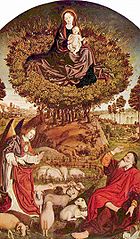
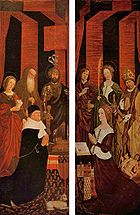
The Burning Bush Triptych of Nicolas Froment
- The Burning Bush triptychTriptychA triptych , from tri-= "three" + ptysso= "to fold") is a work of art which is divided into three sections, or three carved panels which are hinged together and can be folded shut or displayed open. It is therefore a type of polyptych, the term for all multi-panel works...
by Nicolas FromentNicolas FromentNicolas Froment was a French painter.-See also:*Early Renaissance painting...
, an AvignonAvignonAvignon is a French commune in southeastern France in the départment of the Vaucluse bordered by the left bank of the Rhône river. Of the 94,787 inhabitants of the city on 1 January 2010, 12 000 live in the ancient town centre surrounded by its medieval ramparts.Often referred to as the...
painter, is a masterpiece of the 15th century. The painting came from a Carmelite convent, destroyed during the French RevolutionFrench RevolutionThe French Revolution , sometimes distinguished as the 'Great French Revolution' , was a period of radical social and political upheaval in France and Europe. The absolute monarchy that had ruled France for centuries collapsed in three years...
. The central panel represents the Virgin and Child seen on the burning bushBurning bushThe burning bush is an object described by the Book of Exodus as being located on Mount Sinai; according to the narrative, the bush was on fire, but was not consumed by the flames, hence the name...
. In the foreground, MosesMosesMoses was, according to the Hebrew Bible and Qur'an, a religious leader, lawgiver and prophet, to whom the authorship of the Torah is traditionally attributed...
, guarding his flock, is amazed by the vision. The two other parts of the triptych show the patrons of the work, King René I of NaplesRené I of NaplesRené of Anjou , also known as René I of Naples and Good King René , was Duke of Anjou, Count of Provence , Count of Piedmont, Duke of Bar , Duke of Lorraine , King of Naples , titular King of Jerusalem...
, also ruler of Provence, and his consort Queen Jeanne, in devotional attitudes.
Other notable works in the cathedral include:
- Christ on the Cross with the Virgin of Sorrows, Saint Peter and Saint Antoine, (1640), by Jean DaretJean DaretJean Daret was a Flemish-French painter.-Biographie:Jean Daret was born in Brussels in 1613.He was appointed an official painter for King Louis XIV. He specialised in decorating mansions, namely Chateau de Chateaurenard, at Rue Gaston Saporta, in Aix-en-Provence.He died in Aix-en-Provence at age...
(père), in the Chapel of the Sacred Heart; - The Last Supper, (1668) by Jean DaretJean DaretJean Daret was a Flemish-French painter.-Biographie:Jean Daret was born in Brussels in 1613.He was appointed an official painter for King Louis XIV. He specialised in decorating mansions, namely Chateau de Chateaurenard, at Rue Gaston Saporta, in Aix-en-Provence.He died in Aix-en-Provence at age...
(fils), in the south section of the transept; - The Incredulity of St. Thomas, by the Flemish painter Louis Finson (1613) in the lower part of the Gothic nave;
- A set of seventeen tapestries of the life of Christ, bought in 1656 by the chapter thanks to a legacy from Archbishop Michel Mazarin. The tapestries were among twenty-six originally woven in 1511 for Canterbury CathedralCanterbury CathedralCanterbury Cathedral in Canterbury, Kent, is one of the oldest and most famous Christian structures in England and forms part of a World Heritage Site....
in England, and decorated the choir there until 1642, when they were taken down during the English Civil WarEnglish Civil WarThe English Civil War was a series of armed conflicts and political machinations between Parliamentarians and Royalists...
. They made their way to Paris, where they were bought by the chapter and placed in the choir of the cathedral. The tapestries were stolen during the French Revolution, but repurchased by the Archbishop of Aix. In 1977, the first nine tapestries were stolen, and have not been recovered.
Altar of the Aygosi family
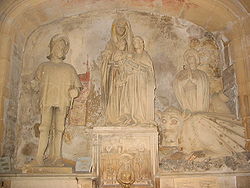
This monument comprises:
- an altar surmounted by a false tabernacle, with, at its edge, the coat of arms of Urbain Aygosi (or Aygosy);
- a tabernacle decorated with a figure of Christ with the inscription "Look, mortal, it is for you that such a victim is delivered";
- a retableRetableA retable is a framed altarpiece, raised slightly above the back of the altar or communion table, on which are placed the cross, ceremonial candlesticks and other ornaments....
of stone with six figures: Saint AnneSaint AnneSaint Hanna of David's house and line, was the mother of the Virgin Mary and grandmother of Jesus Christ according to Christian and Islamic tradition. English Anne is derived from Greek rendering of her Hebrew name Hannah...
with the Virgin Mary, holding the infant Jesus; Saint MauriceSaint MauriceSaint Maurice was the leader of the legendary Roman Theban Legion in the 3rd century, and one of the favorite and most widely venerated saints of that group. He was the patron saint of several professions, locales, and kingdoms...
in a coat of armour of the 15th century; St. Margaret of Antioch with a dragon; and Christ on the Cross. Statues of the Virgin and of St. JohnJohn the EvangelistSaint John the Evangelist is the conventional name for the author of the Gospel of John...
, also once part of this altar, are on display at the Musée Granet. The sculptor of the altar, Audinet Stéphani, was originally from CambraiCambraiCambrai is a commune in the Nord department in northern France. It is a sub-prefecture of the department.Cambrai is the seat of an archdiocese whose jurisdiction was immense during the Middle Ages. The territory of the Bishopric of Cambrai, roughly coinciding with the shire of Brabant, included...
, and worked in Aix and its region between 1446 and 1476.
Aix Cathedral in fiction
- Aix Cathedral features prominently in the urban fantasyUrban fantasyUrban fantasy is a sub-genre of fantasy defined by place; the fantastic narrative has an urban setting. Many urban fantasies are set in contemporary times and contain supernatural elements. However, the stories can take place in historical, modern, or futuristic periods...
novel "YsabelYsabelYsabel is the tenth novel by Canadian fantasy author Guy Gavriel Kay. It was first published in January 2007 by Viking Canada. It is Kay's first urban fantasy and his first book set outside his fantasied Europe milieux since the publication of his first three novels in the 1980s...
" by fantasy author Guy Gavriel KayGuy Gavriel KayGuy Gavriel Kay is a Canadian author of fantasy fiction. Many of his novels are set in fictional realms that resemble real places during real historical periods, such as Constantinople during the reign of Justinian I or Spain during the time of El Cid...
.

